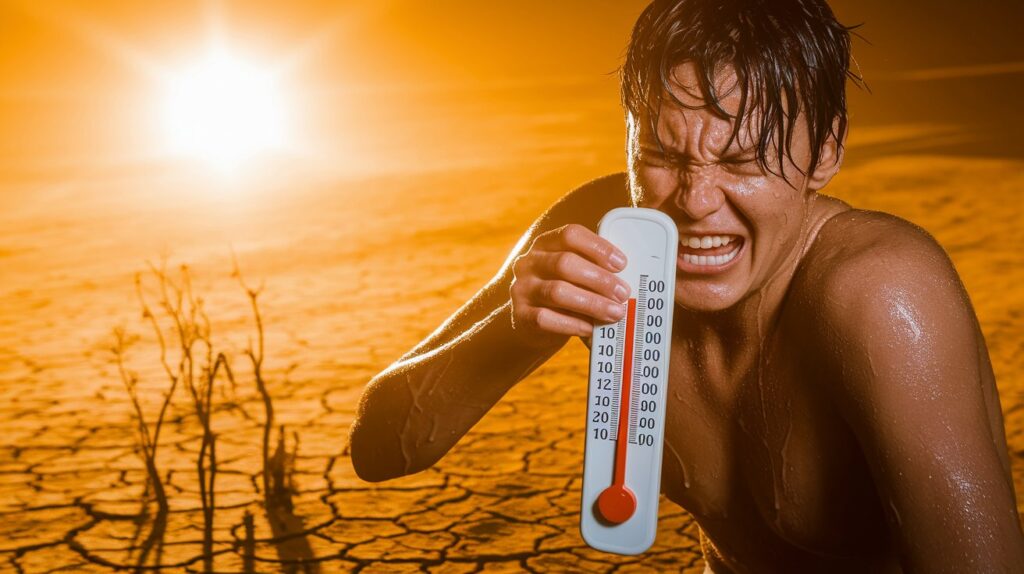As global temperatures continue to rise, heat waves are becoming more frequent and intense. Extreme heat can be dangerous, leading to dehydration, heat exhaustion, and even life-threatening conditions like heatstroke. Protecting yourself and your loved ones during a heat wave is crucial. In this blog, we’ll explore effective strategies to stay cool, hydrated, and safe when the mercury soars.

Understanding the Dangers of a Heat Wave
Before diving into prevention, it’s important to recognize the risks of extreme heat:
- Dehydration – Loss of fluids through excessive sweating.
- Heat Cramps – Painful muscle spasms due to electrolyte loss.
- Heat Exhaustion – Symptoms include dizziness, nausea, heavy sweating, and a rapid pulse.
- Heatstroke – A medical emergency where the body overheats (above 104°F or 40°C), leading to confusion, loss of consciousness, and organ failure.
Now, let’s discuss how to protect yourself.
1. Stay Hydrated
Water is your best defense against heat-related illnesses.
✅ Drink Plenty of Water – Even if you’re not thirsty, sip water throughout the day.
✅ Avoid Alcohol & Caffeine – These can dehydrate you faster.
✅ Electrolyte Balance – Drink coconut water or oral rehydration solutions (ORS) to replenish lost salts.
🚫 Myth: Drinking extremely cold water cools you down faster.
Fact: Room-temperature water is absorbed better by the body.
2. Dress Smartly
What you wear can significantly impact your body temperature.
✅ Lightweight, Loose Clothing – Cotton and linen allow better air circulation.
✅ Light Colors – Dark colors absorb heat; white or pastel shades reflect sunlight.
✅ Wide-Brimmed Hat & Sunglasses – Protect your face and eyes from direct sun exposure.
🚫 Avoid synthetic fabrics that trap heat and sweat.
3. Limit Outdoor Activities
The sun is strongest between 10 AM and 4 PM.
✅ Stay Indoors – If possible, remain in air-conditioned or well-ventilated spaces.
✅ Plan Outdoor Work Early or Late – Schedule physical activities for early morning or evening.
✅ Take Frequent Breaks – If working outside, rest in the shade every 30 minutes.
🚫 Never leave children or pets in parked cars—temperatures can rise to deadly levels within minutes.
4. Keep Your Home Cool
If you don’t have air conditioning, try these methods:
✅ Use Fans Strategically – Place a bowl of ice in front of a fan for a DIY cooler.
✅ Close Curtains & Blinds – Block out direct sunlight during peak hours.
✅ Cross-Ventilation – Open windows at night when it’s cooler.
✅ Cool Showers or Wet Towels – Apply damp cloths to your neck, wrists, and forehead.
🚫 Avoid using the oven or stove—opt for no-cook meals instead.
5. Best Foods to Eat in a Heat Wave
Certain foods help regulate body temperature and hydration:
🍉 Water-Rich Fruits – Watermelon, cantaloupe, strawberries, and oranges.
🥒 Hydrating Vegetables – Cucumbers, celery, lettuce, and zucchini.
🥛 Probiotic Foods – Yogurt and buttermilk aid digestion and keep you cool.
🍵 Herbal Teas – Mint, fennel, or chamomile tea (cooled) can be refreshing.
🧊 Light & Easy Meals – Salads, smoothies, and chilled soups prevent overheating.
🚫 Avoid heavy, oily, or spicy foods—they increase metabolic heat.
6. Emergency Cooling Techniques
If you or someone else is overheating, act fast:
❄️ Ice Packs & Cold Compress – Apply to pulse points (wrists, neck, armpits, groin).
🚿 Cool (Not Ice-Cold) Bath – Sudden extreme cold can shock the body.
🌬️ Misting Spray Bottle – Spritz water on skin and sit near a fan.
🍃 Wet Sheet Technique – Drape a damp sheet over yourself while lying down.
⚠️ If Heatstroke is Suspected (Confusion, No Sweating, High Fever):
- Call emergency services immediately.
- Move to shade, cool with wet cloths or ice packs.
- Do NOT give fluids if unconscious.
7. Recognize Heat-Related Illnesses
Early intervention can save lives.
Heat Exhaustion Symptoms:
- Heavy sweating
- Weakness or dizziness
- Nausea or vomiting
- Cold, clammy skin
Action: Move to a cooler place, sip water, and apply cool compresses.
Heatstroke Symptoms:
- High body temperature (above 103°F)
- Hot, dry skin (no sweating)
- Confusion or unconsciousness
- Rapid, strong pulse
Action: Call emergency services immediately. Move to shade, cool the person with ice packs or wet cloths, but do not give fluids if they’re unconscious.
8. Protect Vulnerable Groups
Some people are at higher risk:
- Elderly individuals
- Infants and young children
- People with chronic illnesses (heart disease, diabetes)
- Outdoor workers
✅ Check on Neighbors & Family – Ensure they have access to water and cooling.
✅ Use Cooling Centers – Many cities open air-conditioned shelters during extreme heat.
Final Thoughts
Heat waves are not just uncomfortable—they can be deadly. By staying hydrated, dressing appropriately, avoiding peak sun hours, and recognizing warning signs, you can protect yourself and others.
Remember: Prevention is always better than cure. Stay cool, stay safe, and share these tips to help others beat the heat!
🔥 Did you find this helpful? Share it with friends and family to spread awareness!
